
Poker is a card game that requires skill, concentration, and luck. It can be a fun and rewarding way to spend your time. However, it’s important to understand the game before you start playing. This article will explain the basics of poker, including how to form a hand and what the different bets mean. It will also discuss strategies and tips for winning at the game.
The basic goal of poker is to win the pot, which is the sum total of all the bets placed by players. The best way to do this is by having the highest-ranking hand at the end of each betting round. A player can also win the pot by bluffing, which involves betting with a weak hand and hoping that other players call, giving them an advantage.
Position is one of the most important factors in poker. It determines how many hands you play and when. In general, you should raise more hands in late position than you do in early position. This will make you more likely to be in late position when your opponents are, and it will increase your chances of winning.
There are several different types of hands in poker, and each one has its own rules for when to play it. For example, a straight is a hand with consecutive cards of the same suit, such as five of clubs. A flush is a hand that has four of the same suit and includes a pair of jacks or higher. A royal flush is a poker hand that contains a king, queen, jack, and ace of the same suit.
To play poker, you must learn to read other players and watch their body language. This is especially important for new players, who may be prone to acting on impulse. They might bet too much or play a hand they should have folded. By observing experienced players and imagining how they would react in a given situation, a newbie can develop quick instincts that will help them avoid making costly mistakes.
In addition to reading other players, you must also know how to spot “tells.” These tells can include a player’s nervous habits such as fiddling with their chips or wearing a ring. They can also be a player’s betting patterns, such as raising pre-flop with a dubious hand.
The art of poker is in the details, and the more you understand these details, the better you will be able to play. There are many books on the subject, but the best one is The One Percent, which teaches you to think about poker from a 10,000-foot view and then breaks down each aspect of the game into manageable pieces. Another good book on this topic is The Mathematics of Poker, by Matt Janda. This book goes into a lot of detail, but it’s not for the faint of heart. It is, however, an excellent companion to The One Percent course and will help you refine your approach to the game.
